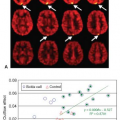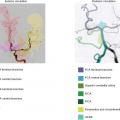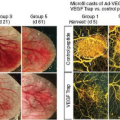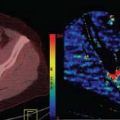Velocity-Selective Arterial Spin Labeling
Eric C. Wong
Lawrence R. Frank
Introduction
In both pulsed arterial spin labeling (pASL) and continuous ASL (CASL), the spatial separation between the site of arterial labeling and the target tissue creates a delay between the time that the labeling pulse is applied and the arrival of tagged blood in the tissue. This is referred to as the transit delay, δt, or sometimes as the bolus arrival time. For ASL in the brains of healthy subjects, this delay is typically 0.5 to 1.5 seconds, which is similar to the T1 relaxation time of arterial blood. It is these two time parameters that fundamentally set the time scale of the ASL experiment. To allow for delivery of labeled blood to the tissue, a delay that exceeds δt must be inserted between the application of the label and image acquisition, and increasing the delay generally increases the amount of labeled blood delivered. At the same time, the ASL signal decays away with time constant T1 after the application of the label, and increasing the postlabeling delay (PLD) to allow sufficient time for the label to reach the capillaries comes at a significant cost in T1 decay and therefore signal-to-noise ratio (SNR). This tradeoff is central to the selection of timing parameters for ASL. In healthy subjects, this tradeoff is manageable, and robust quantitative ASL methods have been demonstrated using both pASL and CASL tagging methods.
In slow or collateral flow, transit delays from the labeling site to the target tissue can be lengthened. In cerebrovascular disease, transit delays can be much longer than the T1 relaxation time of blood1 (delays up to 10 seconds or more are not uncommon in acute stroke), rendering accurate measurement of cerebral blood flow (CBF) using conventional pASL or CASL difficult or impossible in these regions. Velocity-selective ASL (VSASL)2,3,4 was introduced specifically to address this issue. In VSASL, the labeling of arterial magnetization is based on the velocity of blood flow, rather than on the spatial location of the feeding arteries. Blood whose velocity is above a threshold is labeled regardless of location, and after a delay, images are acquired of labeled magnetization that has decelerated through the velocity threshold into static tissue or slow-flowing microvasculature. In principle, this approach removes the spatial separation between the labeling location and the target tissue, reduces or eliminates the problem of long transit delays, and thereby allows for accurate quantitation of CBF when flow is slow and/or circuitous.
Theory
VSASL takes advantage of the fact that arterial blood decelerates as it flows from larger arteries to smaller arteries and into the microvasculature, while venous blood accelerates as it flows through the venous tree. The VSASL pulse sequence is shown schematically in Figure 20.1. A velocity threshold, or cutoff velocity, Vc, is chosen, and blood that is flowing with velocity |V| > Vc is tagged using a velocity-selective pulse module. After a delay Inversion Time (TI), a second velocity-selective saturation pulse module is applied to saturate spins with |V| > Vc, and an image is acquired. To remove static tissue signal, which is naturally at |V| < Vc, a control image is acquired in which a velocity-selective tag is not applied, and an image is acquired after a saturation pulse that saturates |V| > Vc. As in conventional ASL, the tagged image is subtracted from the control image to obtain the VSASL signal. By using these velocity-selective filters in both tagging and imaging phases of the pulse sequence, the VSASL signal is restricted to spins that were at |V| > Vc at the time of the tag and at |V| < Vc at the time of imaging. Only spins that decelerate through |V| = Vc at some time during the TI interval will appear in the VSASL signal. The volume of blood that decelerates through |V| = Vc in a time interval TI is simply CBF * T1. As in other ASL methods, the ASL signal depends not only on the amount of tagged blood delivered but also on the degree of magnetization (the tagging efficiency) and T1 decay. Although velocity-selective inversion (instead of saturation) would be ideal, pulses that produce inversion over a broad range of velocities without perturbing static spins have not yet been introduced. Current VSASL methods employ velocity-selective saturation, and the difference in the longitudinal magnetization of arterial blood between tag and control states immediately following the
tagging pulses is therefore M0B, the equilibrium magnetization of arterial blood. Accounting for T1 decay, the simplified signal equation for the VSASL signal is:
tagging pulses is therefore M0B, the equilibrium magnetization of arterial blood. Accounting for T1 decay, the simplified signal equation for the VSASL signal is:
The effects of the velocity-selective pulses are depicted schematically in Figure 20.2. In the ideal case, the velocity-selective tagging pulse would produce a sharp cutoff of magnetization above V = Vc, but in practice, the velocity selectivity is typically a sinc function as shown in Figure 20.2A (see Velocity Selective Pulse Design section later). The control pulse nominally produces no modulation of the magnetization, and the difference between the tag and control profiles (shown in gray in Fig. 20.2A) represents the net tag. The velocity range covered by the tag maps to the upstream portions of the arterial tree as shown in Figure 20.2B. After a delay TI, the second saturation pulse removes potential signal from these upstream vessels and thereby localizes the VSASL signal to tagged magnetization that has moved to downstream arteries, arterioles, and capillaries, as well as tissue water via water exchange (Fig. 20.2C). As in conventional ASL, because most tissues have a large tissue water compartment compared to the blood water compartment and the exchange of water is fast between capillaries and tissue, the amount of tagged arterial water that reaches the venous side prior to image acquisition is typically negligible. In addition, because of the velocity filter |V| < Vc that is applied prior to imaging, the VSASL signal is even further attenuated in veins. An example quantitative CBF map obtained using VSASL is shown in Figure 20.3, along with a similar map from the same subject, acquired using pulsed ASL (PICORE/QUIPSS II)5. The images are on the same scale and are very similar both qualitatively and quantitatively.
Localization of the Velocity-Selective Arterial Spin Labeling Signal
The VSASL signal arises from spins with |V| < Vc, and the choice of Vc is therefore a key factor in the localization of the VSASL signal. In the ideal case, Vc would be chosen to correspond to the velocity of the arterioles that feed into capillary beds. This would restrict the VSASL signal to capillaries and tissue, thereby guaranteeing excellent localization of the signal to the target tissue. But the velocity of blood entering capillary beds is approximately 1 mm/s, and the use of a cutoff velocity that is this low would result in severe sensitivity to subject motion, brain pulsatility, and diffusion effects (see later) and would not be useful. In practice, a cutoff velocity of approximately 1 cm/s is achievable without severe sensitivity to these sources of artifacts. For most of our measurement, Vc = 2 cm/s. The vessel size that corresponds to this velocity is approximately 50 μm,6 and in the brain this is the approximate size of the arteries that penetrate the cortical surface. Thus, for this value of Vc, the VSASL signal will be localized downstream from these penetrating arteries and therefore appear in brain tissue, rather than in surface arteries or farther up the arterial tree. Use
of higher Vc results in further reduced sensitivity to artifacts but also in signals appearing farther upstream. As in all ASL methods, the VSASL signal is not guaranteed to appear in the voxel in which the perfused tissue resides but is more likely to do so for low values of Vc. In some implementations of conventional pulsed or continuous ASL, flow-weighting gradients are added in the imaging pulse sequence specifically to reduce artifacts from upstream arterial blood and can be identical in implementation to the second velocity-selective pulse in VSASL. Although in VSASL it is an integral part of the scheme to quantify CBF by performing |V| < Vc filtering, however, in conventional ASL it can complicate quantitation by saturating an unknown amount of upstream tagged blood.
of higher Vc results in further reduced sensitivity to artifacts but also in signals appearing farther upstream. As in all ASL methods, the VSASL signal is not guaranteed to appear in the voxel in which the perfused tissue resides but is more likely to do so for low values of Vc. In some implementations of conventional pulsed or continuous ASL, flow-weighting gradients are added in the imaging pulse sequence specifically to reduce artifacts from upstream arterial blood and can be identical in implementation to the second velocity-selective pulse in VSASL. Although in VSASL it is an integral part of the scheme to quantify CBF by performing |V| < Vc filtering, however, in conventional ASL it can complicate quantitation by saturating an unknown amount of upstream tagged blood.
In some pathologic states, slow-flow conditions may exist, which place the spins with |V| = Vc further upstream than in healthy subjects, resulting in a displacement of the VSASL signal upstream. For this reason, the optimal choice of Vc may depend on the range of velocities present in a particular application.
Transit Delay Insensitivity
Because the velocity cutoff is the same for both the tagging process and the velocity filter that is applied prior to image acquisition, there is no gap, either in velocity space or physical space, across which the tagged blood must travel to produce a VSASL signal. This is the most important distinction between VSASL and conventional pulsed or continuous ASL, where there is a spatial gap between the tagging slab or plane and the imaging volume, resulting in a transit delay. Indeed, the arteries that are tagged in VSASL are often within the imaging volume itself. The VSASL signal is thus inherently insensitive to transit delays and, in principle, capable of accurate measurement of CBF in slow and/or circuitous routes of circulation in disease. In conventional, spatially selective ASL, slow flow results in increased transit delays. These delays require increased PLDs to avoid quantification errors and result in lower SNRs owing to label decay T1 relaxation during the PLD time, as well as the potential for residual errors when the maximum potential transit delays are underestimated. In VSASL slow flow does not result in an artifactual decrease in the overall ASL signal, but in an upstream displacement of the detected signal as described in the previous section on localization.
Direction Dependence
In VSASL, velocity-selective pulse trains are used to saturate flowing spins. The design of these pulse trains is discussed in more detail later, but the general idea is that flow-weighting magnetic field gradients (similar to phase-contrast or diffusion-weighted MRI) are used to modulate the phase of flowing spins, and that a nonuniform distribution of velocities due to laminar, turbulent, or multidirectional flow produces phase cancellation and results in saturation of the net magnetization among flowing spins. Phase accrual will only occur if spins are moving along the direction the flow-weighting gradient is played out. Thus, using this approach, velocity-selective saturation is sensitive to only one direction of flow, defined by the direction of the velocity-encoding gradients. Unlike diffusion-weighted imaging, however—where usually three or more measurements with different diffusion-encoding directions are used—it is not necessary to repeat the VSASL measurement in different directions to correctly measure perfusion. As described previously, the choice of Vc determines the location in the vasculature at which spins upstream from this location are tagged by saturation and spins downstream are imaged. This location also depends on the direction of velocity encoding, because it is the location at which the component of the flow velocity in the direction of the velocity encoding decelerates through Vc (see Fig. 20.4). For vessels that are aligned with the direction of the velocity-encoding gradient, this will occur farther downstream, whereas for vessels that are nearly perpendicular to the velocity-encoding gradient, this will occur farther upstream. Empirically, in healthy subjects, the VSASL signal is relatively independent of the direction of velocity encoding for Vc < 4 cm/s but is significant for higher Vc.2 The choice of Vc necessary to achieve direction independence in slower flow will probably be lower, and the optimization of this parameter will have
to be determined empirically for applications in which slow flow is likely.
to be determined empirically for applications in which slow flow is likely.
Diffusion Weighting
In VSASL, the difference between tag and control conditions is that in the tag condition, flow-weighting gradients are applied in the velocity-selective tagging pulse module, whereas in the control condition gradients are not applied. This produces the desired saturation of flowing spins in the tag condition but also imparts a small amount of diffusion-related attenuation.2,3,7 For Vc = 2 cm/s, the b-factor of this diffusion weighting is approximately 1 s/mm2, which results in a signal attenuation in gray matter of approximately 0.1%. Although this attenuation is relatively small, it is not negligible compared to the VSASL signal itself, which is approximately 1%. Moreover, diffusion attenuation in cerebrospinal fluid (CSF) is approximately three times higher than in gray matter, and because CSF is in close proximity to gray matter, particularly over the cortical surface, diffusion-related tag–control signal differences in CSF can contaminate the VSASL signal. Several approaches have been taken to minimize or correct for this effect. First, for a given flow weighting, the diffusion b-factor is reduced with a longer time separation between the two lobes of the flow-weighting gradients.2 This is because the flow moment varies linearly with both time separation and gradient area, whereas diffusion weighting varies linearly with the time separation but quadratically with the gradient area. Thus, for a given flow moment a longer time separation with a smaller gradient area results in lower diffusion weighting. The tradeoff is that a longer time separation also results in increased T2 decay, which directly reduces the VSASL signal. In addition, pulse sequence modifications have been introduced either to null the CSF signal by inversion8 or to measure and remove the contribution of CSF to the VSASL signal.9
Stay updated, free articles. Join our Telegram channel

Full access? Get Clinical Tree












